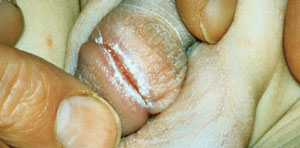
A Lesion That Should Raise Suspicion
Am Fam Physician. 2000;62(9):2095-2096
During a particularly hot and humid period in July, a five-year-old boy presented to the office with a three-day history of erythema, swelling and tenderness of the penis. No dysuria, hematuria, abdominal pain or fever was present. During the previous weeks, the patient had frequently played in a swimming pool.

Question
Discussion
The answer is B: strangulating hair. Paraphimosis occurs when the foreskin is retracted beyond the coronal ridge and cannot be moved forward, which can lead to penile edema. It would not, however, be expected to cause a fissure. The history and physical examination were inconsistent with the diagnosis of noncandidal balanitis, which is associated with allergic contact dermatides, such as those caused by poison ivy and neomycin.
A diagnosis of candidal rash might be contemplated because of the macerated penis and the history of a moist environment. However, this is less common in children and Figure 2 provides a clue to the actual cause, which is something other than a fungus.
The end of a fine hair may be identified in the area of the swelling (see arrow, Figure 2). The hair was wrapped circumferentially along the corona sulcus, slowly strangulating the glans of the penis.
Gently tugging on the hair could not remove it. A small suture scissors was used to “fish” for the deeply embedded hair. The hair was successfully cut, and the swelling and erythema quickly improved over three days. Some cases have required more invasive surgery to find and remove the embedded hair.
